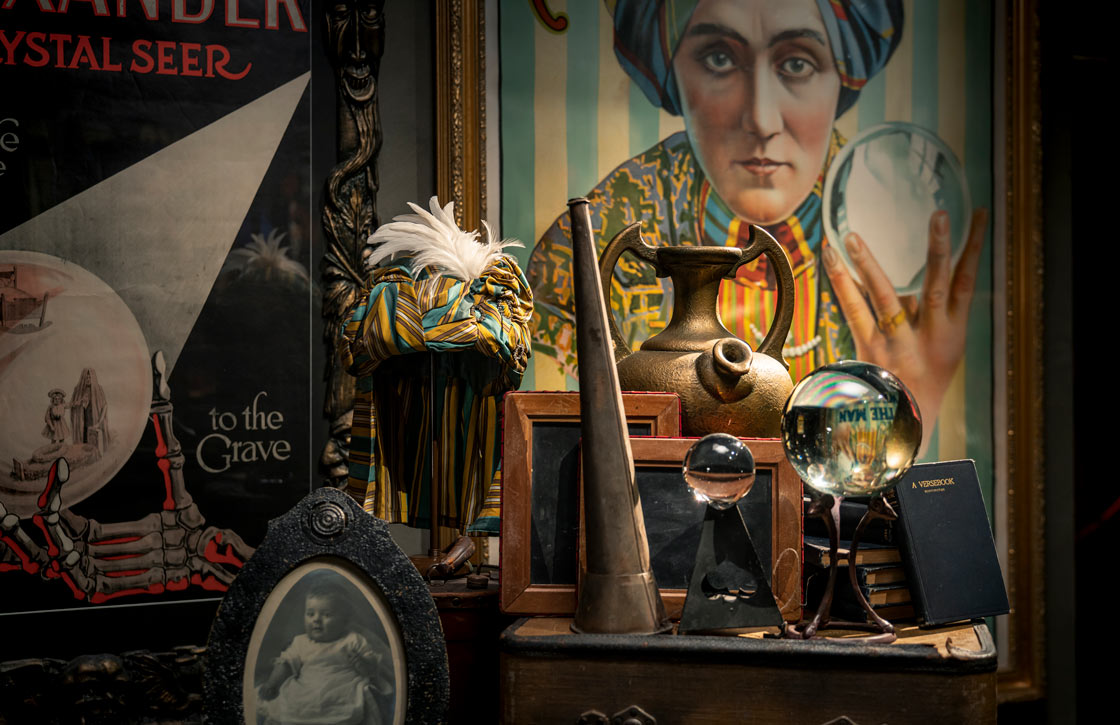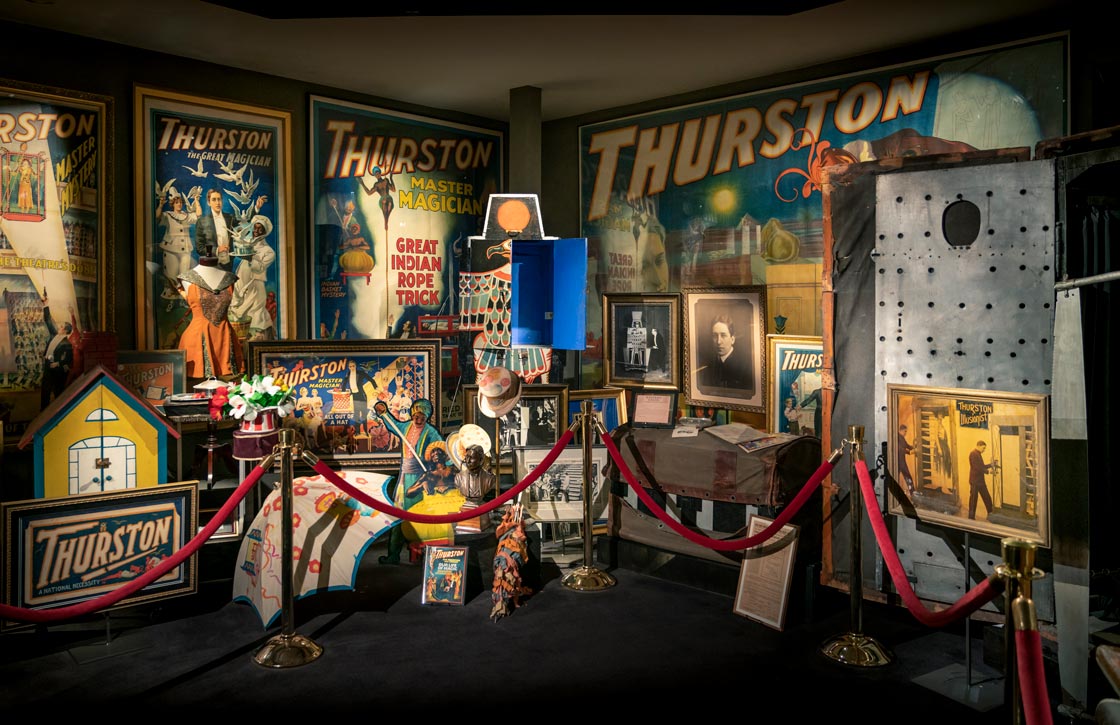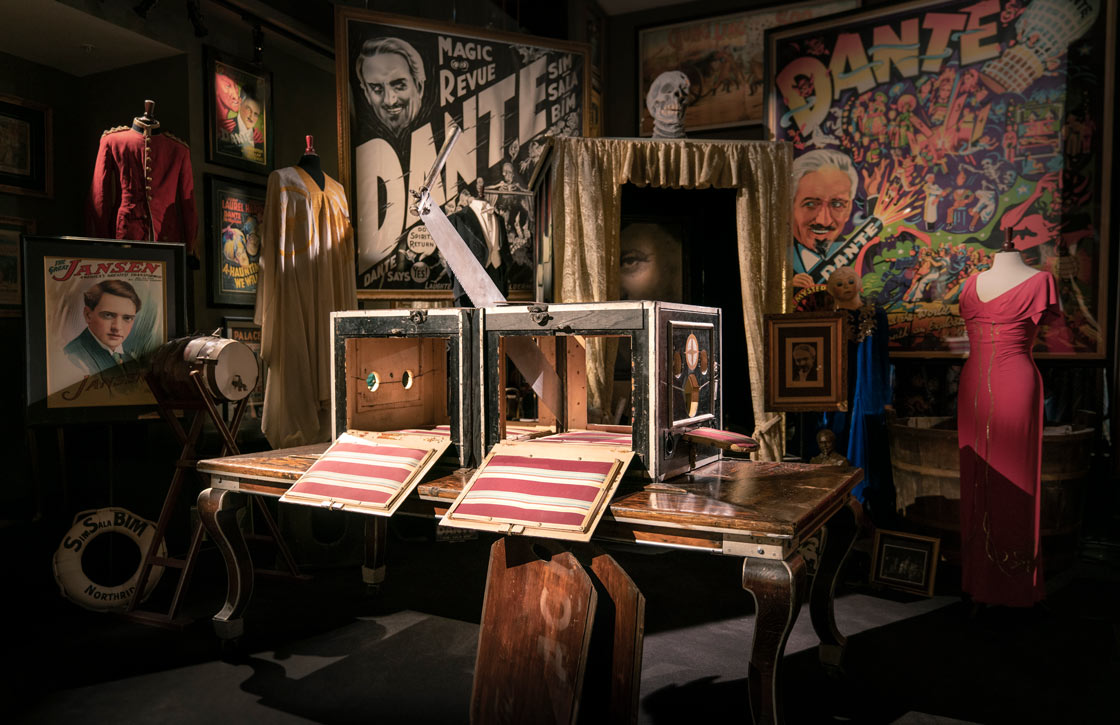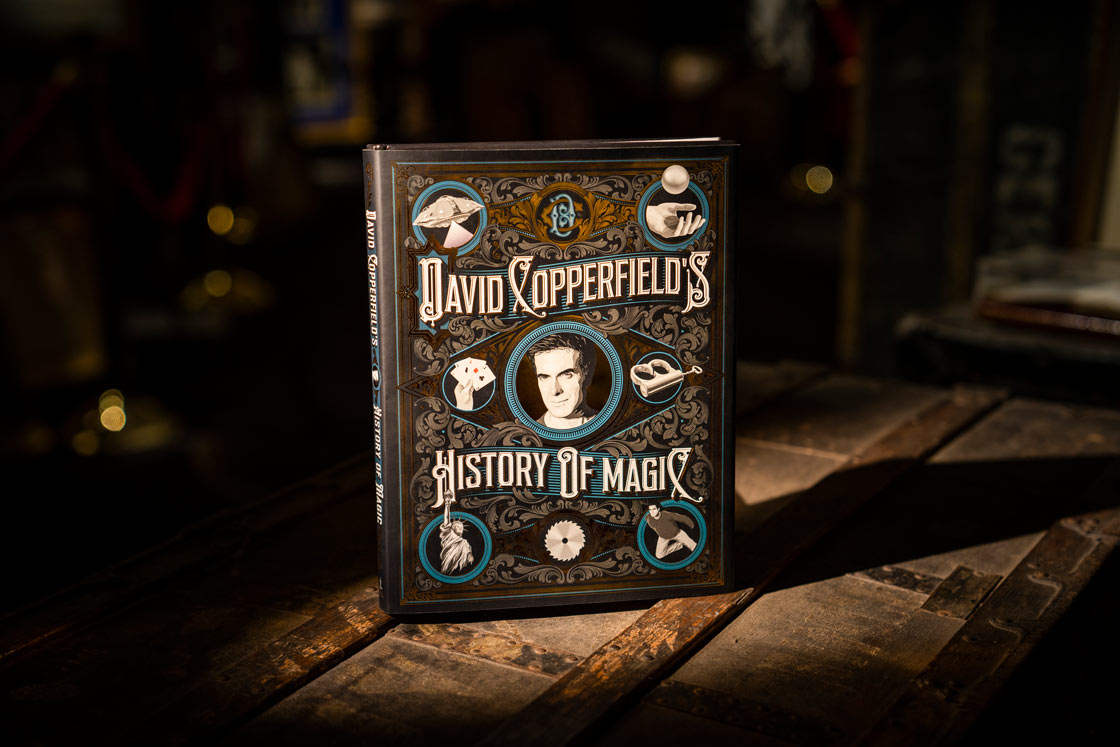David Copperfield’s History of Magic is a concise and lavishly illustrated history of stage magic from the late 19th century to the present. It is told in David’s voice, so I applaud Mr. Copperfield for giving equal credit to coauthors Richard Wiseman and David Britland. Their book is fabulous, in part, because it is more than a series of biographies. Although most of the famous U.S. magicians are featured (Houdini, Thurston, Blackstone), the book is organized around artifacts of the performer or topic, a novel approach that gave me a greater sense of what it was like to see the great magician perform than did the biographical chapters in wordier histories. While a few well-chosen common images have been included, most of the book’s illustrations are of artifacts that have been exquisitely displayed in Copperfield’s private museum and photographed in color by his talented design director, Homer Liwag.
The first chapter can be seen as a prelude, as it is from a much earlier time than the rest of the book. The Discoverie of Witchcraft by Reginald Scot was controversial and well known when it was published in 1584 because the author took a skeptical stance against witchcraft and its prosecution. To argue this fully, Discoverie includes two chapters generally believed to be the first significant discussion of magic tricks in the English language. One is on specialized props visible from a distance. However, the other, on handheld magic, was more influential among would-be magicians, partly as a result of having been plagiarized for the next century. A history of magic devoting a whole chapter to this seminal book is uncommon, but merited.

Artifacts belonging to “Alexander, the Man Who Knows” (Claude Alexander Conlin, 1880-1954)
To its credit, David Copperfield’s History of Magic features the choice of devoting a whole chapter to the 1876 book by Professor Hoffman, Modern Magic, and its sequels. Even those earlier books that did not rely on Scot’s Discoverie were not much more than exposés of magic secrets. Hoffman’s books, however, were the first to teach magic, and they sold well. Focusing on the unique notebooks of the author was the only time I found the artifact vehicle to be a bit of a stretch. However, a visitor to Copperfield’s museum noticed something significant in the notebooks that was new to me, and to their credit, the three authors of David Copperfield’s History of Magic give him the credit. Nonetheless, they rightly concentrate on Hoffmann’s hugely influential books, which, unfortunately, most magic histories do not give the attention they deserve.
Aside from the Scot, most histories of magic also limit discussion of magic tricks done with handheld objects, known within the trade as “close-up” magic (or “micro magic” in Europe). I therefore applaud Copperfield et al. for devoting one later chapter to the 20th century’s most influential single book on card tricks, and two other chapters to celebrated closeup performers. Although first published in 1902, Artifice, Ruse, and Subterfuge at the Card Table, remarkably remains in print (as The Expert at the Card Table). While much of its influence is due to its new techniques, it is also famous for having an author, S.W. Erdnase, who admitted to using a pseudonym and to being a card cheat.
When the leading magician’s magazine asked subscribers to rank the top ten of a pre-selected list of 100 magicians who most influenced magic in the 20th century, David Copperfield came in at #3 (deservedly the highest ranked living magician), the ubiquitous Houdini at #2, and Dai Vernon at #1. How did a relatively unknown magician—outside of magic circles, that is—beat Copperfield and Houdini? For the last quarter of the 20th century, Dai Vernon was very well-known within the magic community as a teacher of sleight of hand. His two most famous pupils were Ricky Jay and Doug Henning. Vernon had also been paid high fees to perform card tricks for the rich and famous. Copperfield’s book is the first general history of magic to give him a wellearned whole chapter. Max Malini, a leading 19th century closeup performer, also earns a chapter.
Copperfield’s Magic also has chapters on two leading magic prop retailers, which is especially poignant as magic retail shops are fading with the profession moving online. One, Martinka’s, peaked a century ago and is gone. The other, Tannens, started mid-century and played a large role in Copperfield’s teenage years, and is still in business. As with the chapters devoted to books, the inclusion of shops in this history gives readers a wider introduction to the culture of magic than one finds in most general histories of the subject. Shops are also complementary to the props featured in many of the chapters about specific performers.

Artifacts of American stage magician Howard Thurston (1869–1936) who ran away to join the circus, where his future partner Harry Kellar also performed. Deeply impressed by magician Alexander Herrmann’s show, Thurston was determined to become his equal, and eventually became the most famous magician of his time. Thurston’s traveling magic show was so large that it needed eight train cars to transport.
Most of Copperfield’s 28 chapters are nonetheless about leading stage performers. Two spotlight famous 20th century female magicians, Adelaide Herrmann and Dell O’Dell. Adelaide’s husband Alexander was so well known that he was the prototype of the magician’s look, with top hat, wand, mustache, and goatee, but his career is shoehorned into the chapter on his widow. After he died, Adelaide successfully performed solo magic for another two decades in vaudeville. During the mid-20th century peak of nightclubs, Dell O’Dell was in demand. Her act was quirky but successful, often featuring a bunny rabbit, groan worthy rhymes, and a running gag of dubbing a bald man in the audience “Curly.”
Skeptic readers may be especially intrigued by the chapters discussing magicians who simulated psychic phenomena. The chapter on “Alexander, the Man Who Knows” focuses on his turban, which defined his onstage persona and secretly facilitated then-new radio communication of information from his assistants that he used to awesome effect. He was one of the highest paid performers in vaudeville and received significant additional income, including through the use of unethical and illegal means. The chapter ends with Copperfield’s lament that some magicians pass themselves off as being genuinely psychic. A famous mid-century English theatrical and television mind reader, Koran, is given a chapter as well, not to be confused with the earlier U.S. psychic performer of the same name who appeared most prominently on the radio. Mind reading magician Joseph Dunninger may be more famous, at least in the U.S., than are some of the performers given a chapter of their own.
From the 1930s through the end of the 20th century, tuxedoed magicians in night clubs, theaters, and late-night television talk shows captivated audiences with silent tricks using cigarettes, birds, and endless quantities of playing cards seeming to appear from midair. This stereotype of the magician was pioneered by just two people, Dick Cardini and Channing Pollock. Giving each a chapter of his own is another decision that I applaud. I should note that the Barnes and Noble bookstore exclusive edition includes an additional chapter about Orson Welles’s little remembered performances as a magician.
My biggest concern is that the cover illustrations and title of David Copperfield’s History of Magic could give the erroneous impression that the book is about Mr. Copperfield’s extraordinary career. The opposite is true: the lead author is being modest by giving himself only a few more pages than he gives to other performers.
David Copperfield’s History of Magic is up to date and thorough in its research, such as the exclusion of the notion that magician Robert-Houdin used a magic trick to avert a war, and the authors’ citation of a specialist periodical of only 100 copies. Citing that article is also to the authors’ credit because it critiques the main text’s acceptance of the larger-than-life stories of little-known magician Harry Cooke. I only spotted one error in the book: it is stated that a particular magician performed in the U.S., even though he never did, according to the book the authors cite as their main source.

Harry August Jansen (1883–1955) was a Danishborn magician who traveled the world under the name “Dante the Magician.”
Although most major magicians of the late 19th and 20th centuries are covered, the authors faced difficult decisions regarding whom to include or exclude. For example, Cooke was surely less impactful than John Henry Anderson, and it might seem odd that the book has a full chapter on non-magic novelty act “Loyd, the Human Card Index” rather than, say, on the popular pseudo spiritualist Davenport Brothers, whose work influenced leading magicians for decades. On the other hand, it is reasonable that the book has a U.S. focus and almost no coverage of magicians from the 17th through mid-19th centuries, which simply limits it to the industrial age.

This article appeared in Skeptic magazine 27.2
Buy print edition
Buy digital edition
Subscribe to print edition
Subscribe to digital edition
Download our app
Not getting bogged down in detail can be seen as a strength of David Copperfield’s History of Magic. The most available and comprehensive complementary history book is still Milbourne Christopher’s long and lucid text The Illustrated History of Magic, which Copperfield recommends. Readers looking for fewer names and more intellectual context might want to read Copperfield’s book before consulting The Secret History of Magic by Peter Lamont and Jim Steinmeyer (2018), which I reviewed in Skeptic (Vol. 25, No. 1).
In sum, David Copperfield’s History of Magic is a very good introduction to the history of performance magic, exemplifying how a book that is more than half photos can also be strong in its text. People already familiar with magic history will still want the book for its glimpses into the world’s foremost collection of magic’s most well-known artifacts. ![]()
All photographs in this review by Homer Anthony Liwag, courtesy of Simon & Schuster. Used with permission.
About the Author
Michelle Ainsworth holds an MA in History and she is currently researching a cultural history of stage magic in the United States. She is a humanist and lives in New York City.
This article was published on September 20, 2022.















